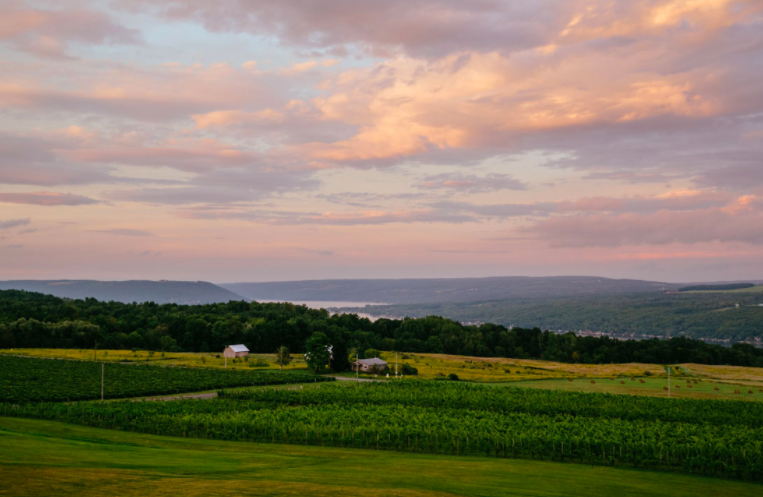The Finger Lakes Region
The New York wine industry is experiencing a dramatic renaissance, with wineries such as Heron Hill leading the way. As the nation’s third largest wine and grape producing state with average annual production of about 20 million gallons, New York State and its distinct regions are earning increased recognition for innovation and quality.

The Finger Lakes Region is one of nine officially recognized viticultural areas in New York (similar to the “appellations of origin” in France). Other regions include Lake Erie, Cayuga Lake, Seneca Lake, Niagara Escarpment, Hudson River Region, Long Island, The Hamptons, Long Island, and North Fork, Long Island. Each region has distinct combinations of soil, topography and climate that make New York State wines unique.
In all of New York’s viticultural areas, the presence of large bodies of water is a crucial element needed for creating ideal “micro-climates” for growing premium grapes. New York’s geographical latitude is similar to that of Europe’s finest grape growing regions. For instance, the Finger Lakes Region also known for its cool climate and for making exceptional Rieslings
The Finger Lakes
Of all New York’s viticultural areas, the Finger Lakes is probably the most diverse in terms of its wine production, making all types of wines from all types of grapes. The area is recognized by many wine publications as having the most important vineyards for wine production in the Eastern United States.

New York State is home to 1,000 vineyards, covering about 3,200 acres of land, producing an average annual grape crop of 175,000 tons of grapes – a $40 million value. About 50 percent of the crop is used for grape juice, 45 percent for wine, and five percent for table consumption. There are presently more than 120 wineries, 10 juice manufacturers, and 25 table grape marketers through the state’s grape growing regions.
The Finger Lakes Region produces more gallons of wine and is home to more wineries than any other wine-producing region of New York. The region produces 85 percent of the 30 million gallons of wine produced annually in the state. Of the 120 wineries found across the state, the Finger Lakes Region hosts nearly 60 of them. The region itself is characterized by the “lake effect” or microclimates created along the glacier-carved Finger Lakes. It is also known for the “air drainage” of sloping hillsides and for the glacial soils conducive to water drainage.
The “Finger Lakes” viticultural area was established in October 1982. The area includes more than 4,000 square miles in Livingston, Monroe, Wayne, Seneca, Ontario, and Yates counties; and portions of Tompkins, Schuyler, Steuben and Cayuga counties.

The region is the second largest grape-growing area in the state, with 10,000 acres of labrusca (native), French-American, and vitis vinifera (European) grapes. The area has been the center of New York’s wine industry since the Civil War. Grape growing and wine production even date back to the 1820’s when a local minister began producing sacramental wine for his parishioners. Today, about 90 percent of the State’s wine is made here (and about 77 percent of the state’s Rieslings).
The Finger Lakes was also the birthplace of the “vitis vinifera revolution” more than 30 years ago. It was in the vineyards surrounding Keuka Lake that Charles Fournier and Dr. Konstantin Frank collaborated on their first vitis vinifera vintages, and proved to skeptics that old-world grapes could indeed thrive in the East and produce world-class wines. Interestingly, Heron Hill is home to one of the oldest vinifera plantings on the East Coast and also maintains the only vinifera planting on Canandaigua Lake.
The Finger Lakes
Ice Age glaciers carved the narrow, deep Finger Lakes, creating ideal conditions for growing grapes. The moving ice masses deposited a shallow layer of topsoil on sloping shale beds above the lakes, providing good soil drainage, crucial for grape growing.
The lakes also provide the vineyards with protection from weather extremes as they retain their summer warmth in the winter and their winter cold in the spring. On cold fall nights, the steep slopes of the shorelines offer no place for cold, dense air to settle. Instead, it slides down to the lake, which is still holding its summer warmth. The lake heats the cold air, causing it to rise and allow more cold air to drain from the hillside. In the spring the process is reversed and the cold water retards budding until the danger of frost has passed. The growing season in the Finger Lakes averages about 190 days, and in recent years has often exceeded 200 days.

